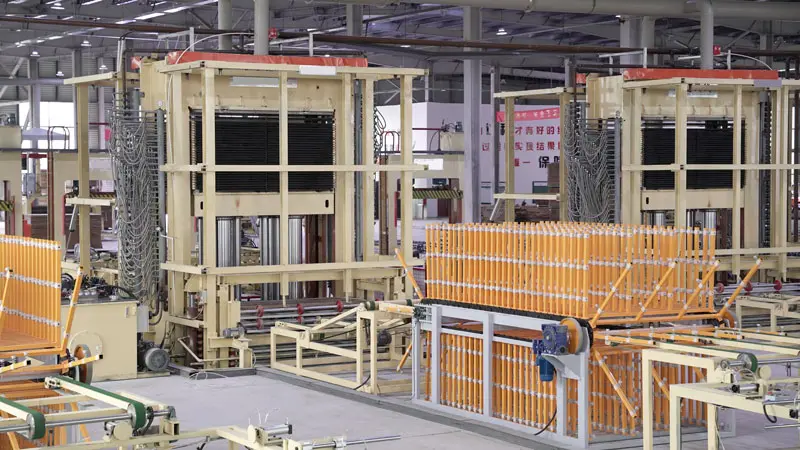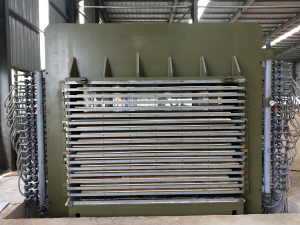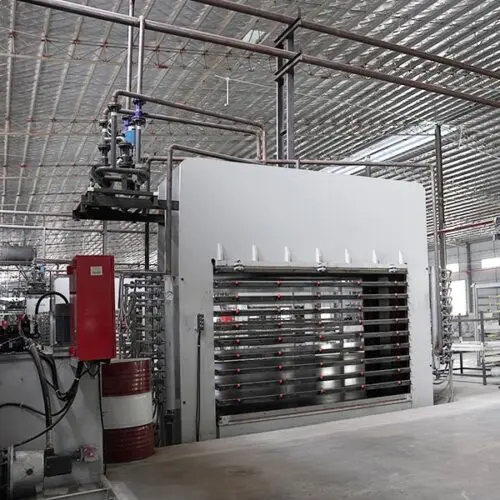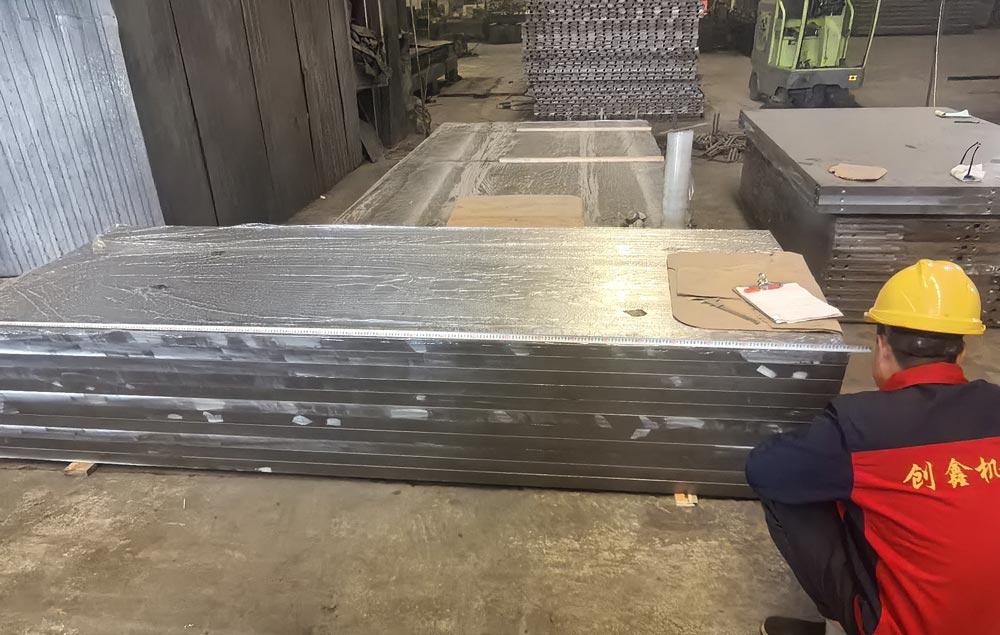أخبار
How Plywood Hot Press Boosts Output by 30%
مرحباً بكم في Chuangxin Automation!
يسعدني وجودك هنا! قبل استكشاف عالم حلول الأتمتة المتطورة لدينا، لنبقى على تواصل دائم - تابعونا على مواقع التواصل الاجتماعي للاطلاع على رؤى القطاع، ونقاشات الخبراء، والتحديثات الفورية. إليكم كيفية التواصل معنا:
🌐 فيسبوك: شركة شاندونغ تشوانغشين لمعدات الأتمتة المحدودة
لنبتكر معًا! سواءً كنتم هنا للحصول على خبرة تقنية، أو تحديثات للمنتجات، أو فرص تعاون، آمل أن تجدوا محتوانا قيّمًا وملهمًا. انضموا إلينا واكتشفوا مستقبل الأتمتة!
تصفح سعيد! 🚀
جدول المحتويات
مقدمة

In the evolving landscape of wood-based panel production, manufacturers are seeking reliable, high-output solutions that can enhance quality while cutting down on labor and operational costs. One of the most effective innovations in this sector is the plywood hot press. Designed to apply heat and pressure to layered veneers, this machine ensures consistent bonding, surface smoothness, and structural strength in finished plywood sheets.
For companies striving to meet large-scale production demands without sacrificing quality, the plywood hot press plays an essential role. It is the heart of many plywood manufacturing plants, especially in competitive markets where efficiency and consistency are non-negotiable.
شركة شاندونغ تشوانغشين لمعدات الأتمتة المحدودة leads the field in manufacturing plywood hot press machines and related hydraulic systems. With a base in Tanyi Town—known as a wood-based board production hub—Chuangxin combines cutting-edge R&D with factory-direct pricing and global logistics, offering exceptional value to plywood producers across more than 60 countries.
How the Plywood Hot Press Boosts Output by 30%
A plywood hot press machine increases production output significantly by improving bonding quality, reducing waste, and automating critical parts of the manufacturing process. This type of machine has become a central component in modern plywood production lines due to its ability to streamline workflows and enhance product consistency. When integrated properly into a manufacturing line, it can boost daily output by as much as 30%—a substantial improvement for high-volume operations seeking greater efficiency and profitability.
The efficiency improvements are not achieved through a single factor, but rather through a combination of advanced features working in harmony. From uniform heating to precise pressure application, the plywood hot press optimizes every step of the pressing process, ensuring that each panel meets strict quality standards while reducing time and resource consumption.
Let’s explore the core efficiency enhancements in more detail.
Key Efficiency Enhancements
1. Uniform Heating Technology
One of the defining features of a modern plywood hot press is its ability to deliver consistent thermal energy across all pressing plates. Traditional pressing methods often suffer from temperature gradients that result in uneven glue curing, leading to defects such as weak bonding, bubbling, or surface irregularities.
However, the plywood hot press uses heated platens—usually made of precision-machined steel with internal thermal oil or steam channels—to ensure that each panel receives consistent heat throughout the cycle. Chuangxin’s advanced oil circuit design, for example, features double inlet and outlet systems that promote even thermal distribution, minimizing temperature variance across the plate surface.
This uniform heating process eliminates undercured glue lines and significantly reduces the risk of delamination. As a result, manufacturers can achieve a higher percentage of first-pass quality panels, avoiding costly rework or material loss.
2. High Pressure Capabilities
While heat is vital for activating adhesives, pressure is equally crucial for achieving a secure bond between veneer layers. The plywood hot press delivers high and evenly distributed hydraulic pressure across the entire surface of the plywood stack. This ensures full contact between layers, enabling adhesives to penetrate and bond effectively.
Modern systems, like those manufactured by Shandong Chuangxin Automation Equipment Co., Ltd., utilize cast-steel hydraulic cylinders with solid quenched alloy plungers. These components are built to maintain consistent pressure over multiple pressing cycles, even under demanding conditions.
Proper pressure application not only improves bonding strength but also helps maintain dimensional stability. Boards come out with consistent thickness, smooth edges, and minimal warping—all essential for downstream applications in furniture or construction.
Furthermore, the uniform pressure reduces the need for post-press trimming or sanding, thereby saving additional time and labor.
3. Automated Control Systems
Precision and consistency are critical in large-scale plywood production. That’s where automation steps in. Today’s plywood hot press machines are equipped with advanced PLC (Programmable Logic Controller) systems that manage temperature, pressure, and pressing time down to the second.
Operators can preset multiple pressing programs for different products, ensuring that the machine adapts quickly to changing production requirements. This adaptability is especially valuable for manufacturers handling a variety of plywood thicknesses, adhesive types, or veneer compositions.
Automation also contributes to process repeatability. Every pressing cycle follows the exact parameters set by the system, which minimizes human error and improves overall production reliability. In cases where real-time monitoring is required, digital displays and alarms can alert operators to any irregularities, enabling prompt adjustments.
This level of control reduces the likelihood of defective products and improves batch consistency—a critical factor for companies with strict quality assurance protocols or export-grade specifications.
4. Time Efficiency
Time savings are perhaps the most directly observable advantage when using a plywood hot press. By maintaining optimal pressing conditions—heat, pressure, and timing—the machine shortens the curing cycle and reduces idle time between operations.
Older methods of plywood bonding often relied on longer pressing times or manual control, which introduced inefficiencies into the production cycle. In contrast, a fully optimized plywood hot press can complete pressing cycles more quickly and with greater accuracy.
For example, a 20-layer plywood hot press system can process large volumes in a single cycle. With automated loading and unloading systems integrated into the machine design, downtime between batches is minimal. Operators can load the next stack of veneer while the current one is still being pressed, creating a seamless workflow.
Over the course of a typical workday, these time savings accumulate. Shorter cycle times mean more batches completed, higher throughput, and ultimately a significant increase in daily production output—often measured at up to 30% more than conventional methods.
In high-demand environments, this increased throughput not only helps meet customer deadlines more reliably but also allows manufacturers to take on additional orders without expanding floor space or adding extra shifts.
Technical Overview of Chuangxin’s Plywood Hot Press


شركة شاندونغ تشوانغشين لمعدات الأتمتة المحدودة offers a line of plywood hot press machines tailored for industrial-scale use. Below is a table highlighting one of their most popular models:
Plywood Hot Press Machine Specification Table
| ميزة | Specification Details |
|---|---|
| Press Type | 500T 20-Layer Hot Press Machine |
| هيكل الإطار | Welded frame with 40 mm steel plate; upper beam: 1000 mm, lower beam: 900 mm |
| حجم اللوحة | 2700 مم × 1370 مم × 42 مم |
| Daylight Spacing | 70 mm |
| Press Plates Quantity | 21 لوحة |
| Press Plate Material | Q355B manganese steel with long diamond-shaped grooves (40 × 40) |
| تسامح التسطيح | في حدود 0.1 ملم |
| طريقة التسخين | Thermal oil or steam |
| Hydraulic Cylinders | 4 cylinders (260 × 1400 mm), cast steel, solid quenched alloy |
| النظام الهيدروليكي | Pollution-free station with Taiwan Jiugang valves and Shanghai pumps |
| نظام التحكم | Fully automatic PLC program control |
| Low-Pressure Pump Motor | 11KW-4 × 2 units |
| High-Pressure Pump Motor | 7.5KW-4 × 1 unit |
The design of this machine enables high daily output with minimal maintenance. With robust materials and a reliable hydraulic system, Chuangxin’s plywood hot press meets the demands of modern manufacturing operations with ease.
Advantages of Using a Plywood Hot Press in Mass Production
Enhanced Adhesion and Structural Integrity
The intense pressure and heat from the plywood hot press ensure the glue penetrates effectively, making the finished board more durable. This minimizes structural failures over time.
Consistent Surface Quality
Uniform pressing results in smoother surfaces across all panels. This reduces the need for post-processing like sanding or re-laminating, saving time and material.
Reduced Material Waste
Because the press ensures strong bonding, fewer panels are discarded due to quality issues. This reduces costs in raw materials and increases overall yield.
Labor Efficiency
Automated loading and unloading systems eliminate the need for multiple manual handlers. This reduces the number of workers required per shift, cutting labor costs substantially.
Versatile Configuration Options
Whether you’re working with standard plywood, laminates, or composites, the plywood hot press from Chuangxin can be tailored to your production goals. Adjustable heating options (thermal oil, steam) allow for application across a range of materials.
Real-World Applications: Who Benefits from a Plywood Hot Press?
ال plywood hot press is used across various industries including:
- صناعة الأثاث: Smooth, durable plywood is ideal for making cabinets, desks, and storage units.
- Flooring Factories: Consistent thickness and high bond strength support long-term durability.
- Construction Industry: Panels made with plywood hot press machines meet load-bearing requirements for flooring and walling.
- Decorative Panel Production: Laminate and veneer finishes benefit from even pressure and heat distribution.
Companies with mass-production goals, tight delivery deadlines, and high quality standards find the plywood hot press indispensable.
Why Choose Chuangxin’s Plywood Hot Press?

As a leader in hydraulic wood machinery, شركة شاندونغ تشوانغشين لمعدات الأتمتة المحدودة offers multiple advantages:
- Global Service: Exporting to over 60 countries with complete logistical support.
- Technical Expertise: In-house R&D for continuous product improvements.
- Competitive Pricing: Factory-direct sales lower the cost-per-unit.
- Durability: Machines are built with high-grade materials for long service life.
- Comprehensive Support: Installation, training, and after-sales service are all included.
With a complete product line including hydraulic pump stations, wood veneer accessories, and panel parts, Chuangxin offers a one-stop solution for manufacturers.
Maintenance Tips to Keep Your Plywood Hot Press Running Smoothly
Routine maintenance is critical to keep your equipment operating at full efficiency.
Daily Checklist
- Inspect the hydraulic system for leaks.
- Check platen temperature settings for consistency.
- Wipe down the surface of the plates to remove adhesive residue.
Weekly Checklist
- Examine the alignment of the press frame and platens.
- Lubricate all moving components as per manufacturer instructions.
- Test PLC control functions for accuracy and timing.
Monthly Checklist
- Drain and replace hydraulic oil if signs of contamination appear.
- Calibrate temperature sensors and control modules.
- Check motor performance and oil pump operation.
خاتمة
ال plywood hot press is not just a machine—it is a production enhancer. By delivering uniform pressure and heat, it streamlines operations, reduces waste, and significantly boosts daily output. For any manufacturer seeking to scale efficiently while maintaining quality, investing in a high-performance plywood hot press is essential.
Shandong Chuangxin Automation Equipment Co., Ltd. stands at the forefront of this innovation, offering reliable, customizable, and globally trusted machines. Their integrated approach—from design to delivery—ensures your production line operates smoothly and profitably.
التعليمات
What materials can the plywood hot press handle?
The machine is designed to press plywood, laminates, MDF, and other engineered wood products. Heating options like thermal oil and steam allow it to adapt to different adhesive types and panel thicknesses.
How often should I service the plywood hot press?
Basic cleaning should be done daily, with more comprehensive inspections and lubrication on a weekly or monthly basis. تشوانجكسين machines are engineered for low maintenance but high durability.
Can I customize the platen size?
Yes. Chuangxin provides customization services, allowing you to adjust the press size, heating method, and number of layers to suit your specific production needs.
Is installation support provided?
Chuangxin offers complete setup assistance, including training for your production team and remote or on-site technical support after installation.
What is the typical delivery time?
Depending on configuration, production, and shipping destination, lead times typically range from 20 to 45 days. تشوانجكسين manages all export logistics directly from its manufacturing base.
أحدث الأخبار
أغسطس 2, 2025
Need a Cold Press Machine Supplier? Learn essential factors to…
يوليو 30, 2025
Cold Press Machine: Reduces waste by 18% & boosts plywood…
يوليو 29, 2025
Looking for a reliable hydraulic press manufacturer? Discover 3 key…
